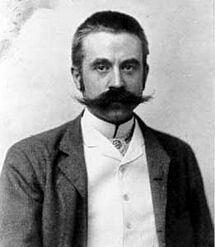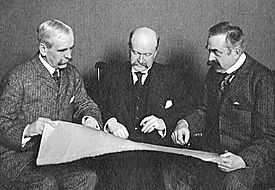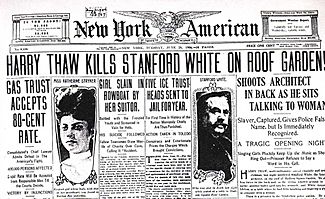Stanford White facts for kids
Quick facts for kids
Stanford White
|
|
|---|---|

Photograph of White by George Cox, c. 1892
|
|
| Born | November 9, 1853 |
| Died | June 25, 1906 (aged 52) New York, New York, U.S.
|
| Occupation | Architect |
| Spouse(s) |
Bessie Springs Smith
(m. 1884) |
| Children | Lawrence Grant White |
| Parent(s) | Alexina Black Mease Richard Grant White |
| Buildings | Rosecliff, Newport, RI Madison Square Garden II, NYC Washington Square Arch, NYC New York Herald Building, NYC Savoyard Centre, Detroit Lovely Lane Methodist Church, Baltimore Rhode Island State House, Providence University of Virginia Rotunda |
| Signature | |
Stanford White (born November 9, 1853 – died June 25, 1906) was a famous American architect. He was a partner in the important architectural firm McKim, Mead & White. This firm was known for its beautiful Beaux-Arts architecture style around the year 1900.
White designed many homes for rich families. He also created many public buildings, schools, and churches. His temporary Washington Square Arch in New York City was so popular that people raised money to build a permanent one. White's designs helped shape the "American Renaissance" style.
In 1906, Stanford White died during a show at Madison Square Garden.
Contents
Early Life and How He Learned Architecture
Stanford White was born in New York City in 1853. His father, Richard Grant White, was a scholar who studied Shakespeare. His mother was Alexina Black Mease. White's father had many friends in New York's art world. These friends included the painter John LaFarge and the landscape architect Frederick Law Olmsted.
White did not go to a special architecture school. Like many architects back then, he learned by working on the job. When he was 18, he started working for Henry Hobson Richardson. Richardson was a very important American architect known for his unique style. White worked with him for six years.
In 1878, White traveled around Europe for a year and a half. He wanted to learn about old building styles and new trends. When he came back to New York in 1879, he joined two other young architects. Their names were Charles Follen McKim and William Rutherford Mead. Together, they started the firm McKim, Mead and White. They agreed that all their designs would be credited to the firm, not to just one person.
In 1884, White married Bessie Springs Smith. She was 22 years old and came from a well-known family on Long Island. Their home, called Box Hill, was a beautiful place. It showed off the fancy designs White could create for his wealthy clients. Their son, Lawrence Grant White, was born in 1887.
Designing Amazing Buildings
In 1889, White designed the famous triumphal arch at Washington Square. Many people believe this is one of his most important works. White was in charge of the Washington Centennial celebration. His first arch was temporary, but it was so liked that money was collected to build a permanent one.
In New York City, White designed many other buildings. These include the Villard Houses (1884) and the second Madison Square Garden (1890). This Madison Square Garden was later taken down in 1925. He also designed the New York Herald Building (1894) and the IRT Powerhouse.
White also designed the Bowery Savings Bank Building (1894) and the Judson Memorial Church. He created the Gould Memorial Library (1903) for New York University. This building is now part of Bronx Community College.
White also worked on important buildings outside of New York City:
- The First Methodist Episcopal Church in Baltimore, Maryland (1887), now called Lovely Lane United Methodist Church.
- The Cosmopolitan Building in Irvington, New York (1895).
- He helped rebuild the Rotunda at the University of Virginia in 1889 after it burned down. (Later, in 1976, his work was changed to bring back Thomas Jefferson's original design.)
- The Boston Public Library in Boston, Massachusetts.
- The Benjamin Walworth Arnold House and Carriage House (1902) in Albany, New York.
He also helped develop Nikola Tesla's Wardenclyffe Tower.
White designed several clubhouses that became important places for New York society. Many of these still stand today. They include the Century, Colony, Harmonie, Lambs, Metropolitan, and The Players clubs. He also designed two golf clubhouses. His Shinnecock Hills Golf Clubhouse is thought to be the oldest golf clubhouse in the United States.
Homes for Wealthy Families
Stanford White was very good at getting projects to design private homes. He was a social person and could draw very well, which helped him convince clients. He could show them how a building would feel and look.
Many of the large homes White designed on Long Island are still standing. These homes often fit into three types: grand chateau-style houses on the wealthy Gold Coast, neo-Colonial homes near his own house in Smithtown, and coastal houses on the South Fork.
White also designed other mansions in New York. These include the Iselin family estate "All View" in New Rochelle. He also designed country homes in Greenwich, Connecticut, and the 1896 Mills Mansion in Staatsburg.
In Newport, Rhode Island, he designed "cottages" like Rosecliff (1898–1902). For Rosecliff, he used ideas from a famous French palace. This mansion was built for big parties and dinners. White's "informal" shingled cottages often had special hallways. These allowed staff to move around without guests seeing them. Bedrooms were also designed to give great privacy.
One of the few city homes designed by White that still exists is the Ross R. Winans Mansion in Baltimore. Built in 1882, it is a great example of French Renaissance style.
White designed Golden Crest Estate in Elberon Park, New Jersey, in 1901. He created it as a gift for a bank president's wife.
White understood how these grand homes needed to work, almost like a fancy hotel or a theater set. He could design magazine covers or pedestals for sculptures. He also expanded what an architect did. He would help with interior decoration, buy art and antiques, and even plan parties. He collected paintings and tapestries for his projects. If he couldn't find the right antique, he would design new pieces of furniture himself.
White was outgoing and social, with many friends and people he knew. Many of them became his clients. He had a big impact on the Shingle Style of the 1880s, the Neo-Colonial style, and the famous Newport cottages.
He designed and decorated grand homes on Fifth Avenue for very rich families like the Astors and the Vanderbilts.
Personal Life
White was a tall man with red hair and a red mustache. People often described him as witty, kind, and generous. Newspapers called him "masterful" and "intense." He collected rare and expensive art and old items. He had a multi-story apartment in Manhattan.
Gallery of Architectural Works
-
Lovely Lane Methodist Church (1884), Baltimore, MD
-
Gould Memorial Library (1903) at Bronx Community College (originally New York University)
-
Washington Square Arch (1891–1895), New York City
-
Cocke Hall (1896) at the University of Virginia
-
Clubhouse (1892), Shinnecock Hills Golf Club, NY
-
Payne Whitney House (1902–1906), New York City
-
Benjamin Walworth Arnold House (1902), Albany, NY
See also
 In Spanish: Stanford White para niños
In Spanish: Stanford White para niños












